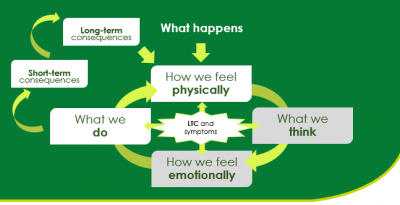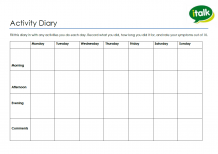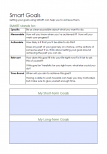Patient Area
3. Avoidance and Boom & Bust
Here you'll find all the worksheets and information you'll need to accompany your learning for Session 3 of our Building Resilience with Long-Term Physical Health Conditions webinar.
What we learned this week
The role of actions in our vicious cycle

This week we focussed on the "what we do" part of our vicious cycle. Often, we can fall into patterns where what we do feels helpful in the short-term but can cause some surprising long-term effects, like feeding into our vicious cycle and making us feel worse.
We explored the two most common patterns: 'avoidance' and 'boom and bust'.
Avoidance
Avoidance is a pattern where we're drawn away from an action or a situation by emotions like anxiety, physical feelings like pain or fatigue, or thoughts like self-doubt. But over time, this can become a vicious cycle that increases those thoughts, feelings and physical symptoms, making us want to avoid the situation or action even more.
For example, if we're avoiding physical activity we will find that over time we lose muscle strength and mobility, and this might increase our levels of pain or fatigue, so we find it even harder to get back into those activities. It can also affect our motivation, so that the less we do the less we want to do.
Boom & Bust
We also explored how the Boom and Bust pattern draws us towards actions. When we're having a good day, we might be drawn to make the most of it and do as much as we can. Then later, we need to take time to rest and recover.
Over time, this can become a pattern where the emotions we feel about pain or fatigue preventing us from doing things, draws us to push ourselves too hard once we recover, and that takes us back to needing to rest again.
How to find a manageable pace
Finding a manageable pace can help us to break those vicious cycles of avoidance or boom & bust.
A good way to do this is to keep a diary for a week or two. For each period of time, write down:
- What you did
- How long you did it for
- How you felt - try to rate this out of 10. E.g. Fatigue 7/10.
This will help you to be more aware of your patterns, and find a 'baseline' level of activity where you feel most comfortable. Your 'baseline' is the range of activity level that if you do less than this, you might notice your symptoms worsen because you're not doing enough to keep up your strength, mobility or motivation, and if you do more than this you might notice your symptoms worsen because you've done too much and need to recover.
Resources: Activity Diary
Setting activity goals
Once you've found your baseline, you can set some goals to help you keep your level of activity around that comfortable baseline level.
We discussed SMART goals in Session 1, and they're helpful here too.
For example: Instead of setting a goal for an afternoon of "cleaning the house" or "resting" we can decide exactly what we will do and how long for, to make sure we stay around that comfortable baseline level of activity.
Using your SMART goals, your activity diary will hopefully become less of a symptom rollercoaster and feel like more of a steady manageable pace. You may find it helpful to continue keeping a diary, if your baseline is likely to vary at times.
Some of our practitioners' top tips for working towards your goals:
- Making these changes will take time, the important thing is to keep going
- Reward yourself for the effort you put in, not the results
- Resting is not giving up, it's giving yourself energy to put in later
- Goals are only guidelines, allow yourself some fun exceptions!
Resources: SMART goals worksheet
Actions
This weeks actions to help you put into practice what you've learned:
- Keep an activity diary to see how different activity levels affect how you feel
Tip: Try to plan in a time to fill it out each evening, so it becomes a habit
- Set yourself some SMART goals towards keeping a comfortable baseline of activity
Tip: Try to really focus on each step of SMART. 'Achievable' and 'Realistic' are particularly important for boom & bust.
- Start working towards your goals
Tip: Carry on keeping your activity diary, to help track your progress.
 Menu
Menu




